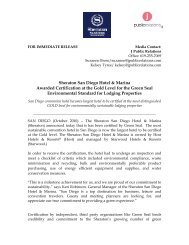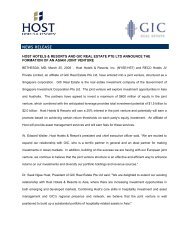Host Marriott 2004 Annual Report - Host Hotels & Resorts, Inc
Host Marriott 2004 Annual Report - Host Hotels & Resorts, Inc
Host Marriott 2004 Annual Report - Host Hotels & Resorts, Inc
You also want an ePaper? Increase the reach of your titles
YUMPU automatically turns print PDFs into web optimized ePapers that Google loves.
of business (i.e. transient or group), property type (i.e. urban,<br />
suburban, resort/conference or airport) and geographic<br />
region. See “Comparable Hotel Operating Statistics” for a<br />
complete description of our comparable hotels and further<br />
detail on these classifications.<br />
Comparable Hotel Sales by Customer Mix. The majority of our<br />
customers fall into two broad groups: transient and group travelers.<br />
Continuing a trend we noted in the first three quarters of<br />
<strong>2004</strong>, the business mix of our portfolio is showing a shift in<br />
transient room nights, from lower-rated discount business to<br />
higher-rated corporate and premium business.<br />
For <strong>2004</strong>, total transient room revenue for our comparable<br />
<strong>Marriott</strong> and Ritz-Carlton hotels was up 6.8% compared to last<br />
year, as premium and corporate occupancy increased to 29.3%<br />
of total transient demand, up from 25.8% last year, while our<br />
average transient room rate increased by 5.4%. This indicates<br />
that our hotel managers are having greater success in reducing<br />
the number of rooms sold at discounted rates as a result of<br />
improving transient demand. We believe the upward trend in<br />
occupancy and average room rate should continue as a result of<br />
increased corporate and premium business in the fourth quarter.<br />
For <strong>2004</strong>, total group room revenue for our comparable<br />
<strong>Marriott</strong> and Ritz-Carlton hotels was up 8.2% compared to last<br />
year, primarily due to an increase in occupancy of approximately<br />
7.5%, while our average group room rate was up slightly, or<br />
0.7%. This increase reflects the increased business travel and the<br />
steady growth in the economy. Additionally, our managers<br />
improved overall occupancy by accepting greater numbers of<br />
advance room reservations for groups, which resulted in fewer<br />
rooms available for transient business. We expect this trend to<br />
reverse in 2005.<br />
Comparable Hotel Sales by Property Type. For full year <strong>2004</strong>,<br />
revenues increased consistently across all of our hotel property<br />
types. Comparable hotel RevPAR increased 6.8%, 6.4%, 7.0%<br />
and 12.0% for urban, suburban, resort/conference and airport<br />
properties, respectively. The largest increases were for our airport<br />
hotels, which reflect a significant increase in business<br />
travel in <strong>2004</strong> compared with the significantly depressed levels<br />
of 2002 and 2003.<br />
The performance of our portfolio is significantly affected by<br />
the size of our hotels, including our large convention hotels, the<br />
majority of which are included in urban properties. Convention<br />
hotels have historically outperformed in the early stages of an<br />
industry downturn; however, they also lag the industry in performance<br />
in the early stages of recovery. This is due to the<br />
longer booking lead-time for large group business and the level<br />
of transient demand required for the greater capacity of rooms.<br />
As with other recoveries, we expect that these hotels will ultimately<br />
outperform and their performance will stay relatively<br />
strong for a longer period of time.<br />
Comparable Hotel Sales by Geographic Region. During <strong>2004</strong>, we<br />
experienced RevPAR gains in most regions. Full year <strong>2004</strong> comparable<br />
hotel RevPAR in our New England region improved 11.0%<br />
over the prior year. The region benefited from the Democratic<br />
National Convention during the third quarter and was led by the<br />
Boston Hyatt, which was converted from the Swissôtel brand in late<br />
2003, where RevPAR improved by 25.6% for the year.<br />
Comparable hotel RevPAR increased 9.2% for our DC Metro<br />
region due primarily to a 5.2% increase in average room rates in<br />
<strong>2004</strong>. Growth was slowed during the year by rooms renovations at<br />
four of our hotels in the region. We expect that the region will experience<br />
strong RevPAR growth in 2005 due to the Presidential inauguration,<br />
the overall strength of the market and the negative effect<br />
of the rooms renovations in <strong>2004</strong>.<br />
For our Atlanta region, comparable hotel RevPAR grew by<br />
6.0%. The improvement was led by The Grand Hyatt, Atlanta,<br />
The Four Seasons, Atlanta and The Ritz-Carlton, Atlanta,<br />
where RevPAR increased 9.7%, 10.9% and 9.9%, respectively.<br />
Our Pacific region, which had lagged behind the portfolio as a<br />
whole during 2002 and 2003, continued to improve as comparable<br />
hotel RevPAR increased 8.0%, with significant increases in occupancy.<br />
The primary reason this region had been underperforming<br />
over the past three years was due to the decline in travel related to the<br />
area’s technology companies, particularly in the San Francisco Bay<br />
area. The improvement in the Pacific region in <strong>2004</strong> reflects an<br />
increase in comparable hotel RevPAR at our San Francisco market<br />
hotels of 14.5%. The results for the Pacific region also reflect a 6.5%<br />
increase in comparable hotel RevPAR at our properties in the Los<br />
Angeles market. Overall, we expect the Pacific region to continue to<br />
exhibit improving performance in 2005.<br />
Comparable hotel RevPAR in our Mid-Atlantic region<br />
improved 10.7% over the prior year. Our New York City properties<br />
benefited from the Republican National Convention in<br />
the third quarter and strong demand in the fourth quarter.<br />
For <strong>2004</strong>, comparable hotel RevPAR in the Florida region<br />
improved 7.1% over 2003. During August and September, four<br />
hurricanes caused significant damage in Florida. Our 12 properties<br />
in the region and the New Orleans <strong>Marriott</strong> experienced varying<br />
levels of property damage and business interruption. During<br />
<strong>2004</strong>, we recorded $3 million of non-recoverable losses. We<br />
believe that the hurricanes could have a modest impact on business<br />
next year, as planners of group business may elect to book<br />
business in other markets during the hurricane season.<br />
RevPAR in other regions was relatively unchanged from<br />
2003. RevPAR declined 0.9% in our South Central region, while<br />
RevPAR in our North Central and Mountain regions experienced<br />
comparable RevPAR increases of 2.2% and 2.7%, respectively.<br />
Comparable hotel RevPAR for our international properties<br />
increased 17.5% for <strong>2004</strong>. Our four Canadian properties, three<br />
of which are in Toronto, experienced increases in RevPAR of<br />
24.5%, as the region has recovered from the SARs related travel<br />
restrictions in 2003 and the effect of the favorable appreciation<br />
of the Canadian dollar compared to the U.S. dollar.<br />
Rental <strong>Inc</strong>ome. Our rental income represents lease income from<br />
our 71 limited-service hotels and three office property leases, as<br />
well as lease income from one full-service hotel. In 2003, operations<br />
at the leased limited-service hotel properties suffered<br />
because a significant portion of these properties underwent renovations<br />
to enable them to compete with newer hotels and the weak<br />
economic conditions in their markets. While several leased properties<br />
were still under renovation in <strong>2004</strong>, the properties that underwent<br />
renovations in 2003 performed substantially better. This was<br />
the primary reason for the increase in total rental income of<br />
$6 million to $106 million during <strong>2004</strong>.<br />
21<br />
HOST MARRIOTT <strong>2004</strong>








